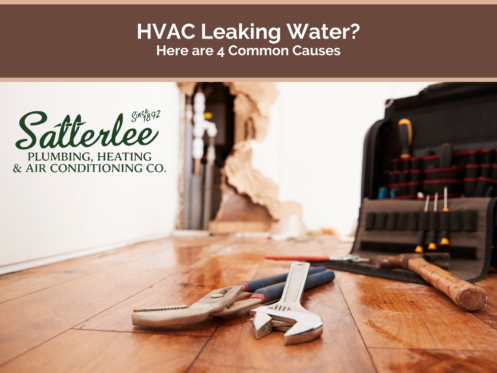HVAC systems naturally create condensation and have a drainage system to catch and dispose of the water created. However, an HVAC leaking water is a sure sign there’s a problem that needs attention. Keep in mind that most problems that cause an HVAC to leak water will need to be resolved by a professional HVAC technician. It’s critical to have an inspection promptly to ensure the water didn’t create additional problems for later.
Typical HVAC Condensation
As a byproduct of the heating and cooling process, water accumulation and the sound of water dripping is normal. When warm air from indoors moves across the coils to cool down, moisture collects on the evaporator coil. Then it drips down into the drainage pan and out through the drainage line. This process occurs every time the unit turns on to adjust the indoor temperature. However, there should never be a large puddle of water around the HVAC unit nor any signs of mold or water stains. If there is pooling water around the unit, here are four potential causes for an HVAC leaking water.
Common Causes of Water Leaks in HVAC
- Clogged Drainage Line: The most common cause of HVAC water leaks is due to clogged drainage lines. Without proper air filter maintenance, debris and dirt will start accumulating within the HVAC unit. The dirt accumulation eventually leads to a buildup which obstructs the drainage system. Another drain line issue could be from its connection to the drainage pan. A loose, detached, or punctured drain line connection can create a steady flow of water compared to a slow drip.
- Frozen Evaporator Coils: In addition to letting dirt and debris into the machine, dirty air filters also limit the airflow around the coils. This can lead to the evaporator coil operating at colder temperatures and eventually freezing. When the system is shut off and allowed to thaw out, the excess water will form from the melting ice. Which will cause the drainage pan and drain lines to overflow, leading to water pooling around the unit
- Malfunctioning HVAC Condensate Pump: Many units have a HVAC condensation pump to help move the flow of water to prevent the drainage pan from overflowing. This is also a part that can clog from dirt accumulation and algae or mold growth. Age is also a factor as normal wear and tear can fail to trigger the float switch to activate the pump. Homeowners may also notice water escaping from any cracks in the pump’s tank or tubing, another sign of old age. It’s recommended to check condensate pumps for clogs and clean them on a monthly basis.
- Damaged Drainage Pan: Age can also affect the drainage pan, creating cracks which water uses to escape the pan instead of draining. Other damages such as the development of rust can also compromise the drainage system. Instead of trying to seal the cracks or clean off the rust, HVAC experts advise on opting for a replacement instead. Typically, the seal added to the drainage pan won’t last and the problem will continue.
Satterlee’s Certified HVAC Specialists
As with any type of leak, the health of your system depends on fixing the issue quickly. If you have concerns about the condition of your HVAC system, request a service call today! At Satterlee, we love helping homeowners and businesses owners feel confident about their HVAC system. So don’t hesitate to reach out with any questions!


